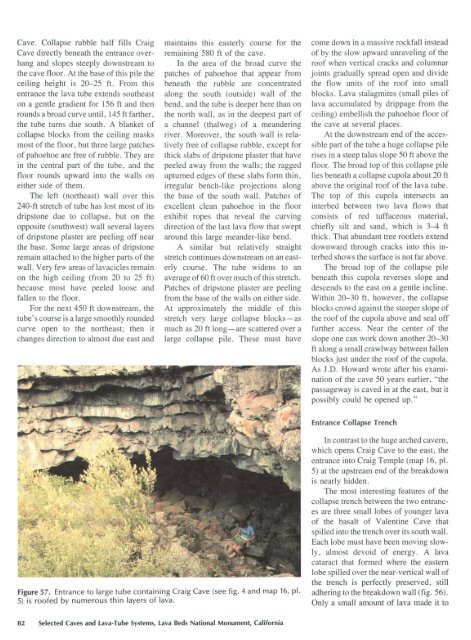Lava cascade in Thunderbolt Distributary of Labyrinth Cave system
report
report
You also want an ePaper? Increase the reach of your titles
YUMPU automatically turns print PDFs into web optimized ePapers that Google loves.
<strong>Cave</strong>. Collapse rubble half fills Craig<br />
<strong>Cave</strong> directly beneath the entrance overhang<br />
and slopes steeply downstream to<br />
the cave floor. At the base <strong>of</strong> this pile the<br />
ceil<strong>in</strong>g height is 20-25 ft. From this<br />
entrance the lava tube extends southeast<br />
on a gentle gradient for 156 ft and then<br />
rounds a broad curve until, 145 ft farther,<br />
the tube turns due south. A blanket <strong>of</strong><br />
collapse blocks from the ceil<strong>in</strong>g masks<br />
most <strong>of</strong> the floor, but three large patches<br />
<strong>of</strong> pahoehoe are free <strong>of</strong> rubble. They are<br />
<strong>in</strong> the central part <strong>of</strong> the tube, and the<br />
floor rounds upward <strong>in</strong>to the walls on<br />
either side <strong>of</strong> them.<br />
The left (northeast) wall over this<br />
240-ft stretch <strong>of</strong> tube has lost most <strong>of</strong> its<br />
dripstone due to collapse, but on the<br />
opposite (southwest) wall several layers<br />
<strong>of</strong> dripstone plaster are peel<strong>in</strong>g <strong>of</strong>f near<br />
the base. Some large areas <strong>of</strong> dripstone<br />
rema<strong>in</strong> attached to the higher parts <strong>of</strong> the<br />
wall. Very few areas <strong>of</strong> lavacicles rema<strong>in</strong><br />
on the high ceil<strong>in</strong>g (from 20 to 25 ft)<br />
because most have peeled loose and<br />
fallen to the floor.<br />
For the next 450ft downstream, the<br />
tube's course is a large smoothly rounded<br />
curve open to the northeast; then it<br />
changes direction to almost due east and<br />
ma<strong>in</strong>ta<strong>in</strong>s this easterly course for the<br />
rema<strong>in</strong><strong>in</strong>g 580 ft <strong>of</strong> the cave.<br />
In the area <strong>of</strong> the broad curve the<br />
patches <strong>of</strong> pahoehoe that appear from<br />
beneath the rubble are concentrated<br />
along the south (outside) wall <strong>of</strong> the<br />
bend, and the tube is deeper here than on<br />
the north wall, as <strong>in</strong> the deepest part <strong>of</strong><br />
a channel (thalweg) <strong>of</strong> a meander<strong>in</strong>g<br />
river. Moreover, the south wall is relatively<br />
free <strong>of</strong> collapse rubble, except for<br />
thick slabs <strong>of</strong> dripstone plaster that have<br />
peeled away from the walls; the ragged<br />
upturned edges <strong>of</strong> these slabs form th<strong>in</strong>,<br />
irregular bench-like projections along<br />
the base <strong>of</strong> the south wall. Patches <strong>of</strong><br />
excellent clean pahoehoe <strong>in</strong> the floor<br />
exhibit ropes that reveal the curv<strong>in</strong>g<br />
direction <strong>of</strong> the last lava flow that swept<br />
around this large meander-like bend.<br />
A similar but relatively straight<br />
stretch cont<strong>in</strong>ues downstream on an easterly<br />
course. The tube widens to an<br />
average <strong>of</strong> 60ft over much <strong>of</strong> this stretch.<br />
Patches <strong>of</strong> dripstone plaster are peel<strong>in</strong>g<br />
from the base <strong>of</strong> the walls on either side.<br />
At approximately the middle <strong>of</strong> this<br />
stretch very large collapse blocks-as<br />
much as 20 ft long-are scattered over a<br />
large collapse pile. These must have<br />
come down <strong>in</strong> a massive rockfall <strong>in</strong>stead<br />
<strong>of</strong> by the slow upward unravel<strong>in</strong>g <strong>of</strong> the<br />
ro<strong>of</strong> when vertical cracks and columnar<br />
jo<strong>in</strong>ts gradually spread open and divide<br />
the flow units <strong>of</strong> the ro<strong>of</strong> <strong>in</strong>to small<br />
blocks. <strong>Lava</strong> stalagmites (small piles <strong>of</strong><br />
lava accumulated by drippage from the<br />
ceil<strong>in</strong>g) embellish the pahoehoe floor <strong>of</strong><br />
the cave at several places.<br />
At the downstream end <strong>of</strong> the accessible<br />
part <strong>of</strong> the tube a huge collapse pile<br />
rises <strong>in</strong> a steep talus slope 50ft above the<br />
floor. The broad top <strong>of</strong> this collapse pile<br />
lies beneath a collapse cupola about 20 ft<br />
above the orig<strong>in</strong>al ro<strong>of</strong> <strong>of</strong> the lava tube.<br />
The top <strong>of</strong> this cupola <strong>in</strong>tersects an<br />
<strong>in</strong>terbed between two lava flows that<br />
consists <strong>of</strong> red tuffaceous material,<br />
chiefly silt and sand, which is 3-4 ft<br />
thick. That abundant tree rootlets extend<br />
downward through cracks <strong>in</strong>to this <strong>in</strong>terbed<br />
shows the surface is not far above.<br />
The broad top <strong>of</strong> the collapse pile<br />
beneath this cupola reverses slope and<br />
descends to the east on a gentle <strong>in</strong>cl<strong>in</strong>e.<br />
With<strong>in</strong> 20-30 ft, however, the collapse<br />
blocks crowd aga<strong>in</strong>st the steeper slope <strong>of</strong><br />
the ro<strong>of</strong> <strong>of</strong> the cupola above and seal <strong>of</strong>f<br />
further access. Near the center <strong>of</strong> the<br />
slope one can work down another 20-30<br />
ft along a small crawl way between fallen<br />
blocks just under the ro<strong>of</strong> <strong>of</strong> the cupola.<br />
As J.D. Howard wrote after his exam<strong>in</strong>ation<br />
<strong>of</strong> the cave 50 years earlier, "the<br />
passageway is caved <strong>in</strong> at the east, but it<br />
possibly could be opened up."<br />
Entrance Collapse Trench<br />
Figure 57. Entrance to large tube conta<strong>in</strong><strong>in</strong>g Craig <strong>Cave</strong> (see fig. 4 and map 16, pl.<br />
5) is ro<strong>of</strong>ed by numerous th<strong>in</strong> layers <strong>of</strong> lava.<br />
In contrast to the huge arched cavern,<br />
which opens Craig <strong>Cave</strong> to the east, the<br />
entrance <strong>in</strong>to Craig Temple (map 16, pl.<br />
5) at the upstream end <strong>of</strong> the breakdown<br />
is nearly hidden.<br />
The most <strong>in</strong>terest<strong>in</strong>g features <strong>of</strong> the<br />
collapse trench between the two entrances<br />
are three small lobes <strong>of</strong> younger lava<br />
<strong>of</strong> the basalt <strong>of</strong> Valent<strong>in</strong>e <strong>Cave</strong> that<br />
spilled <strong>in</strong>to the trench over its south wall.<br />
Each lobe must have been mov<strong>in</strong>g slowly,<br />
almost devoid <strong>of</strong> energy. A lava<br />
cataract that formed where the eastern<br />
lobe spilled over the near-vertical wall <strong>of</strong><br />
the trench is perfectly preserved, still<br />
adher<strong>in</strong>g to the breakdown wall (fig. 56).<br />
Only a small amount <strong>of</strong> lava made it to<br />
82 Selected <strong>Cave</strong>s and lava-Tube Systems, lava Beds National Monument, California















